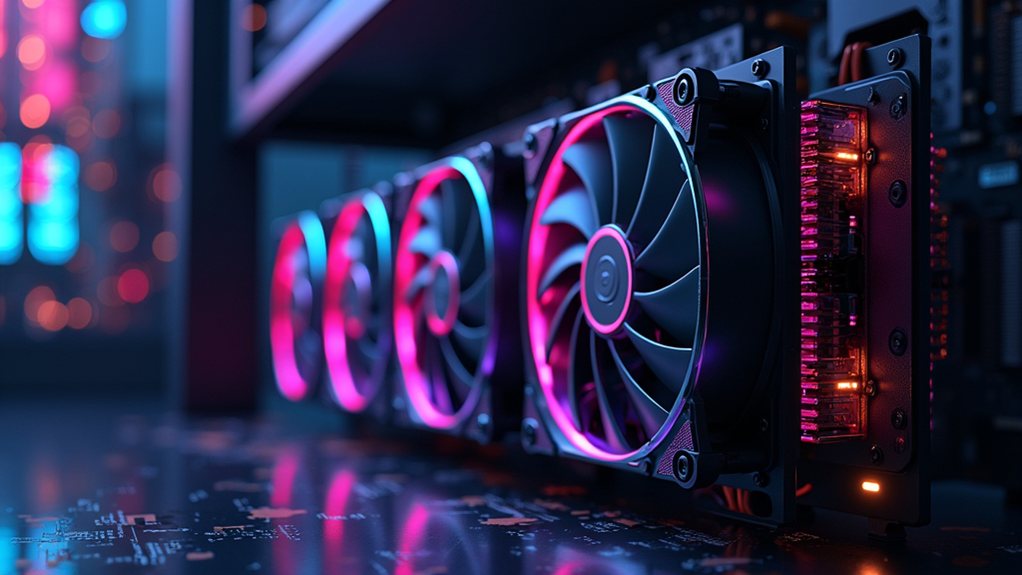Cryptomining is the process of validating cryptocurrency transactions on blockchain networks. Miners use powerful computers to solve complex math puzzles, competing to add new blocks to the blockchain. When successful, they earn digital coins as rewards. The process requires specialized equipment like ASICs or GPUs that perform trillions of calculations per second. Many miners join pools to increase their chances of earning rewards. The environmental impact varies, with some operations now shifting to renewable energy sources.

Cryptomining Explained
Millions of computers around the world are constantly competing in a digital treasure hunt known as cryptomining. This process validates cryptocurrency transactions on blockchain networks while creating new digital coins as rewards for miners. When someone sends Bitcoin or another cryptocurrency to someone else, miners verify this transaction is legitimate and add it to a permanent digital record called the blockchain. This system prevents people from spending the same money twice and keeps the network secure without needing a central authority like a bank.
Cryptocurrency mining turns digital competition into decentralized security, validating transactions while rewarding participants with newly minted coins.
The mining process involves solving complex math puzzles using computer power. Miners race to find a special number that, when combined with transaction data, creates a specific pattern. The first miner to solve the puzzle gets to add a new "block" of transactions to the blockchain and receives newly created coins plus any transaction fees. The most recent Bitcoin halving in April 2024 reduced the reward to 3.125 BTC every 10 minutes. The difficulty of these puzzles adjusts automatically to guarantee blocks are added at a consistent rate, regardless of how many miners are working.
Not all computers are equal in this race. While early Bitcoin miners used regular computers, today's operations use specialized equipment. Application-Specific Integrated Circuits (ASICs) are custom-built for Bitcoin mining, while Graphics Processing Units (GPUs) are often used for other cryptocurrencies. A modern ASIC miner can perform 68 trillion hashes per second, making them significantly more efficient than other hardware options. These machines generate significant heat and require proper cooling systems and powerful electricity supplies to operate efficiently. This proof of work system ensures network security and maintains decentralization across the blockchain.
Many miners join forces in mining pools to improve their chances of earning rewards. By combining their computing power, they're more likely to solve puzzles and receive consistent, smaller payouts based on how much power they contributed. Popular mining pools include F2Pool, Antpool, and Slush Pool, which collectively represent significant portions of various cryptocurrency networks.
The energy used in cryptomining has raised environmental concerns. Bitcoin's network alone uses more electricity annually (204.50 TWh) than some entire countries. This massive energy consumption has prompted criticism about mining's carbon footprint. Some mining operations are responding by moving to locations with abundant renewable energy, while other cryptocurrencies like Ethereum have switched to less energy-intensive systems, reducing power use by up to 99.95%.
Mining profitability depends on several factors. The price of cryptocurrencies can swing dramatically, affecting potential earnings. Block rewards decrease periodically through "halving" events. Electricity costs vary widely by location, and as more miners join a network, the difficulty increases, meaning smaller rewards for each participant.
The regulatory landscape for mining continues to evolve. China banned cryptocurrency mining in 2021, leading to a geographical redistribution of mining activity. The United States now leads with 37.84% of global Bitcoin mining, followed by countries like Kazakhstan, Canada, and Russia. As concerns about energy use grow, more countries may introduce new regulations affecting this rapidly evolving industry.
Frequently Asked Questions
How Much Electricity Does Cryptomining Consume?
Bitcoin mining consumes approximately 150 terawatt-hours of electricity annually, representing 0.5% of global energy use.
That's comparable to Argentina's entire energy consumption.
One Bitcoin transaction uses about 1,200 kWh, equivalent to 100,000 VISA transactions.
The industry uses more electricity than Finland and about 2% of the USA's annual consumption.
About 50% of mining operations utilize renewable energy sources.
What Hardware Is Best for Beginners in Cryptomining?
For beginners in cryptomining, GPUs offer the best entry point.
They're more affordable than ASICs ($300-$2000) and versatile enough to mine different cryptocurrencies.
CPU mining costs almost nothing to start but yields minimal profits.
Some beginners opt for alternative devices like Helium hotspots ($400-$500).
The key advantage of GPUs is they can be repurposed for gaming or sold if mining becomes unprofitable.
Is Cryptomining Legal in All Countries?
Cryptomining isn't legal in all countries. About eight nations have completely banned the practice as of 2024.
China implemented a total ban in 2021, while Egypt, Algeria, Nepal, and Iraq have also outlawed mining activities.
Most countries allow cryptomining but have varying regulations. In places where it's legal, miners often face rules about taxation, energy usage, and financial reporting requirements.
How Does Cryptomining Affect GPU Prices?
Cryptomining greatly impacts GPU prices through basic supply and demand. When cryptocurrency values rise, miners buy GPUs in bulk, creating shortages.
During the 2021 crypto boom, GPU prices reached four times their retail value. Retailers had to limit purchases as gamers struggled to find affordable cards.
When crypto prices crash, the market often floods with used mining GPUs, bringing prices back down. This volatility creates a roller coaster effect on GPU availability and cost.
Can Cryptomining Damage My Computer Over Time?
Cryptomining can damage computers over time. The process runs GPUs at maximum capacity 24/7, generating excessive heat.
This constant strain wears out hardware components faster than normal use. Fans run continuously, shortening their lifespan. Power systems face electrical stress from the constant high demand.
Components experience thermal cycling when systems turn on and off. Dust buildup in mining rigs further reduces cooling efficiency, accelerating deterioration.










